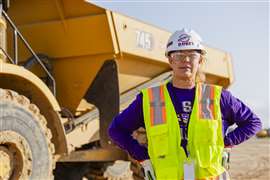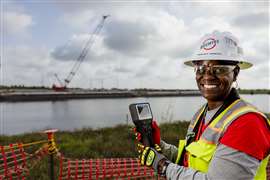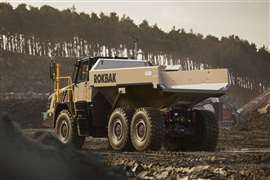Read this article in Français Deutsch Italiano Português Español
Bechtel’s Catherine Hunt Ryan on the battle to recruit more female tradespeople
05 April 2024
Catherine Hunt Ryan, head of manufacturing and technology at infrastructure giant Bechtel is spearheading company plans to recruit hundreds of female electricians, carpenters and plumbers across the US. Lucy Barnard finds out why.
For Catherine Hunt Ryan, head of manufacturing and technology at US-based infrastructure giant Bechtel, the path into the construction industry started with trying to reduce the amount of time women and girls in rural parts of India, Kenya and Morocco spend each day carrying water to their families.
Hunt Ryan saw firsthand how a lack of pipes carrying clean drinking water in remote areas meant that women were making as many as six trips a day, carrying up to 15 litres in jars or buckets on their heads and making it common for girls to drop out of school in order to help out.
“For me it wasn’t until I was working at the World Bank doing water and sanitation work,” Hunt Ryan says. “I got to see how by just delivering clean water and sanitation could have such an impact on communities. I personally became passionate about how literally building infrastructure could mean girls could go to school. Construction more broadly was part of, how do we make this happen? How do we get access to basic services so that women and girls can do more meaningful things with their lives and be more contributing members of society?”
 Catherine Hunt Ryan. Photo: Bechtel
Catherine Hunt Ryan. Photo: Bechtel
In 2007, Hunt Ryan joined privately-owned Bechtel as a development manager, initially working on project finance for wind and solar projects, before a meteoric rise to become leader of one of the five global divisions of arguably the most powerful construction company in the US.
“As a 10-year-old, or as a even as a 20-year old, construction was not on the top of my list of things that I wanted to do. But when I was exposed to it I saw the potential,” she says. “I’m a personal example of when you when you give access when you expose someone to the potential of the industry, you attract and retain people of all different backgrounds.”
And, as head of manufacturing and technology spearheading the construction of some of the world’s biggest battery factories, semi-conductor facilities and chemicals plants, Hunt Ryan sees it as an integral part of her role to bring more women into the business and the industry as a whole.
“The projects we work on require a really large construction workforce,” Hunt Ryan says. “In the US we’re seeing a wave of demand for new manufacturing facilities and other capital projects. We see encouraging women to pursue careers in construction not as optional – not as a ‘nice to have,’ but really as a business imperative.”
Certainly, ‘M&T’ as Hunt Ryan calls it, is currently in the final throes of completing the construction of two new AP1000 nuclear reactors at Plant Vogtle in Waynesboro, Georgia, which, at peak construction employed 8,000 construction workers.
And as main works contractor on the Shell Polymers Monaca polyethylene plant near Pittsburg, Pennsylvania, which completed at the end of 2022, the company employed 8,500 craft professionals during its busiest times.
Manufacturing is driving a US construction boom
Indeed, across the world last year, Bechtel says it was responsible for 190 million hours worked by either direct hires or subcontractors on its construction projects.
And these mega projects are just a taster of the massive need across the US for what is known as ‘craft professionals,’ – the welders, technicians and other manual workers who work on site getting stuff built. According to the US Bureau of Labor Statistics, there are likely to be around 70,000 new job openings each year for electricians, 80,000 for carpenters and 40,000 plumbers, pipe fitters and steam fitters.
 Bechtel heavy equipment operator Robin Moore poses for a photo with an articulated dumper truck in Louisiana. Photo: Bechtel
Bechtel heavy equipment operator Robin Moore poses for a photo with an articulated dumper truck in Louisiana. Photo: Bechtel
“Does the US have enough construction workers to fill the many hundreds of thousands of new jobs these projects will create? Currently the answer to that is no,” says Hunt Ryan. “The way to address the challenge of construction labour is first and foremost to expand the pool of individuals we recruit from – most significantly by attracting and retaining women in construction.”
According to a 2022 analysis of US Bureau of Labor Statistics figures by the Institute for Women’s Policy Research, 353,934 women across the US work as construction craftswomen, just 4.2% of the workforce. Pipefitters were the craft with least female representation, accounting for just 1.1% of the total while female electricians made up just 2.2% of the total and carpenters made up 3.5%.
“If we could find ways to add even half a percent to these figures to move the percentage of women craft professionals to even 4.5% of the total, that would add tens of thousands of new workers,” says Hunt Ryan. “We are doing it because we think it’s the right thing to do. But we also do it because we have the visibility into what our needs will be and how we can build these programmes and then be part of them for years to come.”
Currently, Hunt Ryan says that Bechtel, like many other large US contractors, funds a range of sponsorship programmes, partnerships with local colleges and other initiatives designed to encourage more women to train in the sector to the tune of millions of dollars a year.
“A lot of work has already been put into increasing female participation at the entry point – it can be apprenticeships, technical colleges – but a lot more work is needed to really tap into this workforce,” she says.
Encouraging more women to train as craft professionals
And, she says, some of that is starting to come off. The company reports that out of its workforce of 3,500 direct hire craft professionals, 280 of them – equating to 8% - are female.
“Our number of direct hire craft workers goes up and down depending on where projects are – but we’ve been able to maintain that 8% which is double the national average,” says Hunt Ryan. “That’s not something where we’re going to stop and say that’s great, we’re done. We really see tremendous opportunity to increase this further.”
The key thing to communicate, Hunt Ryan says, is that these jobs are safe as well as highly appealing, highly sought after, well paid, and welcoming.
 Bechtel project environmental lead, Tracey Smith. Photo: Bechtel
Bechtel project environmental lead, Tracey Smith. Photo: Bechtel
“We need to de-mystify some of these careers and do it in a way so that it gets to the right individuals – and then shift the perception as we go,” she says. “That only really shows up in terms of the felt experience of women entering one of our sites and spreading that communication over time.”
As a project manager, Hunt Ryan herself worked on a number of construction sites and has been instrumental in helping to ensure they become more accommodating to women’s needs.
“When you you’re in the field, there’s room for improvement,” she says. “It’s a lot of the smaller things. We say small things, but they really matter. It’s having sufficient female toilets on a site. What is the access to basic amenities and what is our break schedule in places where it’s particularly hot or particularly cold? I worked on our sites as a nursing mother and there were things that that that would have made it easier. But I can also say that now when I go to our sites, we have things like lactation rooms. We have taken some of the feedback and really progressed.”
Internally, the company also runs mentorship programmes and employee resource groups aimed at fostering a more diverse culture.
As one of Bechtel’s five global business unit leaders, reporting to the company’s CEO Brendan Bechtel, Hunt Ryan says she is also pushing to make the company as a whole more representative, encouraging more women into senior technical and leadership positions.
Addressing the gender pay gap
Currently, women represent 29% of all Bechtel’s US employees. In the UK which is the only region to provide a gender pay gap report, women earned on average 23% less than their male counterparts in 2022 and received an annual bonus worth around 45% less.
The company is currently putting together a gender pay gap report for its Australian business due to a new requirement in the Australian law to do so. However, Hunt Ryan says that the company has no plans at present to voluntarily disclose figures for any other parts of its global business. The company also has no plans to assist female employees with childcare.
Hunt Ryan says that part of the company’s overall objective must be addressing the low numbers of women studying science, technology, engineering and maths at high school in the US. According to US government figures, currently only around 20% of engineering graduates and 15% of working engineers are female.
Bechtel has a partnership with the US Society of Women Engineers and invests in a range of community programmes aimed at encouraging STEM subjects, especially close to its main offices.
“We are looking at how we as a company recruit as many of those qualified women as possible,” she says. “But we need to start much earlier than that with STEM programmes. You can’t just start with the graduating population. It has to start with young girls and exposing them to STEM careers.”
“This is a long term, multifaceted investment that we need to make both as an industry and as company,” she says. “And hopefully one day, my 6-year-old daughter and others like her will want to follow in her mom’s footsteps.”
|
STAY CONNECTED


Receive the information you need when you need it through our world-leading magazines, newsletters and daily briefings.
CONNECT WITH THE TEAM











